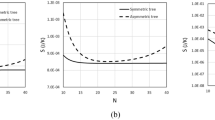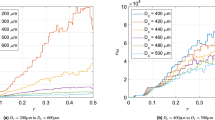Abstract
The bronchial tree is so designed that the functions of the lung can be carried out with minimum entropy production.
This is a preview of subscription content, access via your institution
Access options
Subscribe to this journal
Receive 51 print issues and online access
$199.00 per year
only $3.90 per issue
Buy this article
- Purchase on SpringerLink
- Instant access to full article PDF
Prices may be subject to local taxes which are calculated during checkout
Similar content being viewed by others
References
Weibel, E. R., and Gomez, D. M., Science, 137, 577 (1962).
Weibel, E. R., Morphometry of the Human Lung (Academic Press, Inc., New York, 1963).
Wilson, T. A., Experientia, 20, 33 (1964).
Wilson, T. A., J. Theoret. Biol., 11, 436 (1966).
Campbell, E. J. M., Westlake, E. K., and Cherniack, R. M., J. App. Physiol., 11, 303 (1957).
Author information
Authors and Affiliations
Rights and permissions
About this article
Cite this article
WILSON, T. Design of the Bronchial Tree. Nature 213, 668–669 (1967). https://doi.org/10.1038/213668a0
Issue date:
DOI: https://doi.org/10.1038/213668a0
This article is cited by
-
Quorum-sensing control of matrix protein production drives fractal wrinkling and interfacial localization of Vibrio cholerae pellicles
Nature Communications (2022)
-
Fluid dynamic assessment of positive end-expiratory pressure in a tracheostomy tube connector during respiration
Medical & Biological Engineering & Computing (2022)
-
Constructal Optimization for Tree-Shaped Fluid Networks in a Disc-Shaped Area Subjected to the Surface Area Constraint
Arabian Journal for Science and Engineering (2014)
-
A scaling model for dichotomous branching processes
Biological Cybernetics (1987)
-
Relation between diameter and flow in branches of the bronchial tree
Bulletin of Mathematical Biology (1981)



